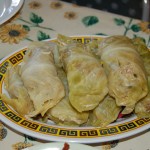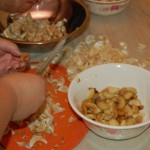
A Hmong shaman blesses a young pregnant woman in rural Merced.
Hmong refugees have been resettling in California’s Central Valley since the late 1970s, when the CIA retreated from their “Secret War” in Laos. Today the Central Valley is a hub for Hmong refugees. Most arrived with few personal belongings, but they did carry their cultural practices with them -- and their recipes. At a traditional Hmong ceremony in the small town of Winton, a few dozen family members gathered to honor a young, pregnant Hmong woman -- Leena Yang. The ceremony was to ensure the healthy birth of the baby and a safe delivery for the mother. "It's like a healing, prevention and protection together. The shaman welcomes the baby soul to the world," said Changvang Her, a Hmong translator.
First the shaman, May Yang, and her husband prepare an altar with offerings of eggs, uncooked rice, paper money and incense. The eggs, the shaman explains through an interpreter, are toys for the shaman spirits to play with. The rice is for the spirits to eat if they get hungry. Family members then spread a plastic sheet across the living floor, and carefully laid a slaughtered pig on the sheet. The pig had a rope wrapped around its belly that led to another rope, wrapped around the belly of a pregnant woman. For the next two hours the shaman chanted while she swayed back and forth and played ceremonial bells. The chants, she later explained, are prayers to the spirit world, offering the slaughtered pig as a sacrifice in exchange for a healthy birth. Throughout the ceremony, the shaman's husband burns pieces of the paper money as offerings to help the shaman pass through different spiritual levels, or realms.

May Yang, the shaman, rattles ceremonial bells to help the unborn baby's spirit.




















